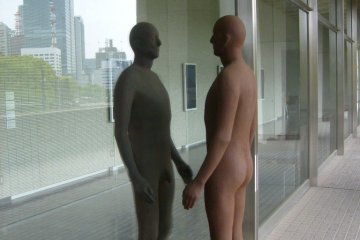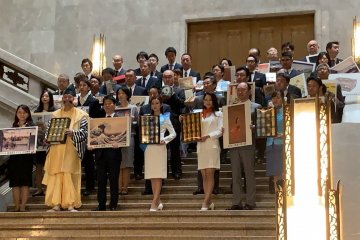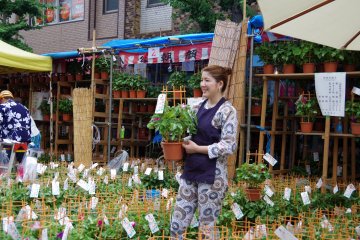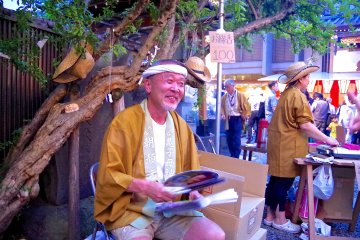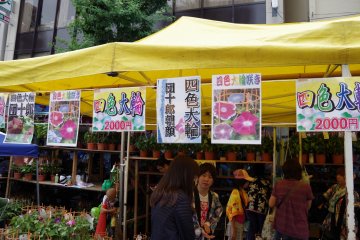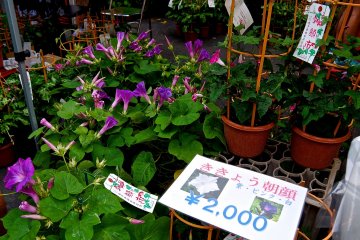Asagao 朝顔 (morning glory) is a very popular flower in Japan. Japanese people enjoy these short-lived pretty summer flowers mainly at home. We plant seeds in the garden or buy potted flowers to help stay cool in summer. As the name tells us, they bloom in the morning and close around noon. People in Edo (old Tokyo) loved and enjoyed the morning glory very much and strove to develop various hybrids. This tradition has been handed down to modern day Tokyo, and the Morning Glory Festival of Iriya (Iriya Asagao Market) held each year from 6-8 July is one of the most popular events of the summer.
Iriya Morning Glory Festival
Iriya, a 1-minute walk from Iriya Subway Station on the Hibiya Line or a 5-minute walk from JR Uguisudani Station on the Yamanote Line, is a town of Kishimojin (the goddess of childbirth and children). Around the temple of Kishimojin, more than 100 morning glory stalls are set up from early morning (6 AM). At night (from around 7 PM), 100 food stands open side by side, and so we can enjoy both the beautiful morning glories and various inexpensive Japanese foods.
Boom of the Morning Glory in the 19th Century
Surprisingly, the cultivation of morning glories boomed in Edo among its people in the first half of the 19th Century. Everyone tried to crossbreed a new and unique flower, and some people even published illustrated books about morning glories. Here is a link to one of the most famous books, called “Asagao Sanju Rokka Sen” (朝顔三十六花撰, published in 1854).
Under such popularity, around 1844, a painter produced a masterpiece featuring morning glories. The painter’s name is Kiitsu Suzuki, one of the great artists of the Rimpa School.
“Morning Glories”
“Morning Glories” (Collection of the Metropolitan Museum of Art, NY) was a work that Kiitsu painted in his later years. The flowers are much larger than those we know now. They are all exactly 15 cm in diameter. It is so impressive. More than 150 purple flowers are painted onto a folding screen. His purple is deep and thick. And the flowers are swinging and dancing upon a golden background, as if they are enjoying music.
Kiitsu Suzuki (1796-1858)
Kiitsu was born in 1796 to a family of dyers in Edo. His serious color choice for the deep purple in his “Morning Glories” might have been influenced by this. When he became 18 years old, he was apprenticed to a famous samurai painter, Hoitsu Sakai. At first, Kiitsu was faithful to Hoitsu’s brushwork. But later, he completely changed his style and touch. That was after a great 10-month tour to western Japan.
Turning point & development of his own style
During his travels from February to November in 1833, he enthusiastically copied old paintings kept in local temples and shrines. At the same time, while visiting places of scenic beauty, he was deeply impressed by the magnificent landscapes he saw. He sketched them repeatedly. These experiences helped him find his own style. One work strongly influenced by his outdoor sketches is 'Mountain Stream' (Nezu Museum, Omotesando). The strong contrast of green leaves and blue stream draws us into his passionate world.
Although people in Edo didn’t know “Mendel’s laws of heredity” (the paper was published in 1856), they succeeded in developing various types of morning glories, mainly through trial and error. The morning glory is a symbol of summer, and at the same time a symbol of the wisdom of the people of Edo.




